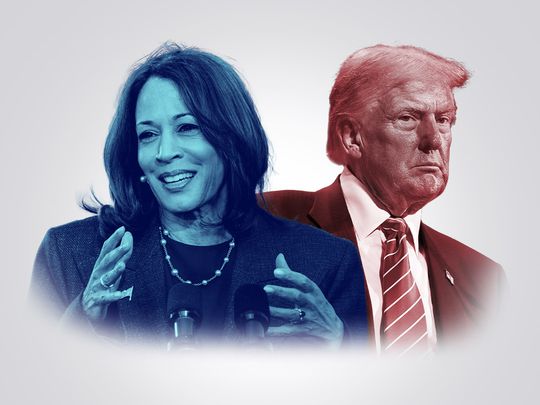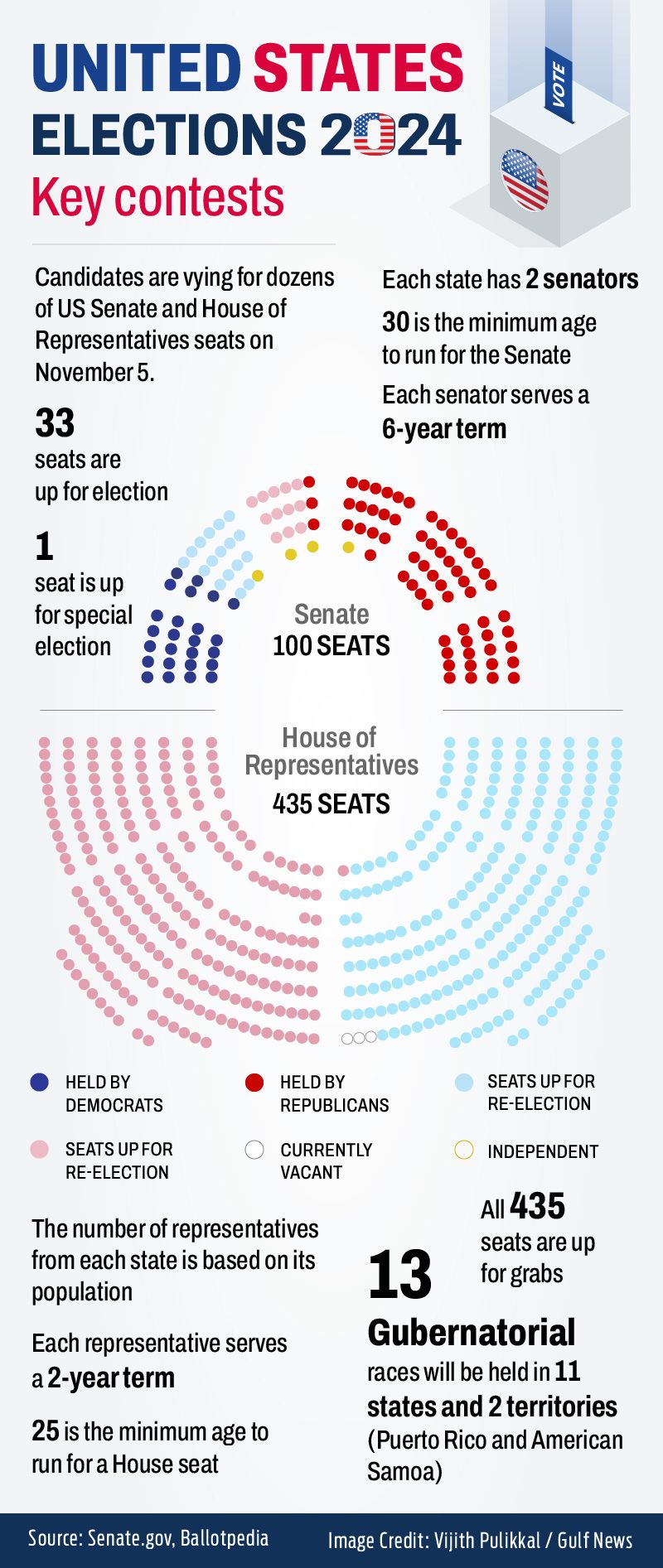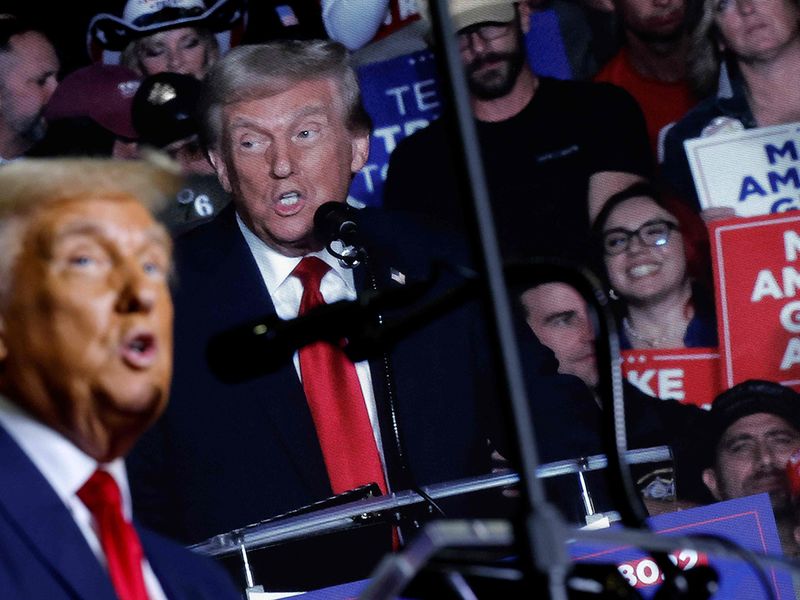
Dubai: In one of the closest contests in modern American history, US Vice President Kamala Harris and former president Donald Trump are making closing arguments before the November 5 election.
And in the handful of critical states, there is little to separate the two contestants.
Under the US Constitution, America’s founding fathers established that each of the 50 states would hold its own vote for president.
Under the complex Electoral College system, each state has a certain number of “electors,” based on population. Most states have a winner-take-all system that awards all electors to whoever wins the popular vote.
With candidates needing 270 of the 538 electoral votes to win, elections tend to be decided in the hotly contested “swing states” with a history of alternating between Republican and Democratic candidates.

How does the Electoral College work?
There are 538 electoral votes. The number is equal to the total voting membership of the US Congress – 435 representatives plus 100 Senators plus 3 from the District of Columbia. The target to win the presidency is 270 electoral votes, or one more than half the Electoral College votes.
Technically, Americans cast votes for electors, not the candidates themselves. Electors are typically party loyalists who pledge to support the candidate who gets the most votes in their state. Each elector represents one vote in the Electoral College.
How are electors distributed around the country?
Each state gets a particular number of electors based on its population size. For example, California has 54 electoral votes. If a candidate wins in California, he/she gets all 54 Electoral College votes, and if a candidate loses, he/she gets none. In short, the winner takes all.
This is why presidential candidates want to win states with many Electoral College votes. The six states with the most electors are California (54), Texas (40), New York (28), Florida (30), Illinois (19), and Pennsylvania (19).
On the other hand, sparsely populated Alaska, Delaware, Vermont and Wyoming have only three electors each.

What are safe states and swing states?
Certain states have a long history of voting for a particular party. These are known as safe states. For example, in four election cycles, in 1996, 2000, 2004 and 2008, Democrats could count on states like Oregon, Maryland, Michigan and Massachusetts, whereas the Republicans could count on states like Mississippi, Alabama, Kansas and Idaho.
States that are teetering between the Republican and Democratic parties are called swing or battleground states.
This time, seven swing states are likely to decide the winner – Pennsylvania, Georgia, North Carolina, Michigan, Arizona, Wisconsin and Nevada.
Every one of these states is a toss-up within the margin of error. Here’s a look at why these states are so important for the 2024 polls.

Pennsylvania (19 Electoral College votes)
Pennsylvania was once reliably Democratic, but not anymore.
In 2016, Republican Donald Trump narrowly won the state, which has a population of 13 million, by just 0.7 percentage points. However, Joe Biden flipped it in 2020, securing a 1.2-point victory. The state, known for its “Rust Belt” cities like Philadelphia and Pittsburgh, has faced economic challenges due to the decline of its industrial manufacturing sector over the past few decades.
Both Trump and Kamala Harris have campaigned vigorously in Pennsylvania, where they held their sole presidential debate. Following a July rally in the state where he survived an assassination attempt, Trump is focusing on appealing to rural white voters, expressing concerns about the impact of migrants on small towns. Meanwhile, Harris is promoting recent infrastructure achievements and, during a visit to Pittsburgh, proposed a $100 billion investment in manufacturing — an issue that resonates strongly with local residents.
Georgia (16)
This southeastern state became a critical battleground at the end of Trump’s first term, and tensions continue to simmer. Prosecutors in Georgia indicted Trump for election interference after he pressured state officials to “find” enough votes to overturn Biden’s narrow 2020 victory. However, a favourable development for Trump is that the case has been paused until after the election. Biden made history as the first Democrat to win Georgia since 1992. Demographic shifts are expected to work in Harris’s favour, as she actively engages with minority voters throughout the state.
North Carolina (16)
This southeastern state has voted Democratic only once since 1980, but Harris believes it is once again competitive. With a population exceeding 10 million, the state is becoming more diverse, which could benefit Democrats. For Trump, a scandal involving the Republican gubernatorial candidate has angered party officials, raising concerns that it could jeopardise his chances in a tight race. Similar to neighbouring Georgia, the aftermath of Storm Helene — which recently devastated towns in western North Carolina — could also influence voter sentiment.
Michigan (15)
Trump flipped Michigan, a state that had been a Democratic stronghold, during his 2016 campaign against Hillary Clinton. Biden reclaimed it for the Democrats in 2020, thanks to strong support from unionised workers and a sizeable Black community. However, this time, Harris faces the risk of alienating the 200,000-strong Arab-American community, which has criticised Biden — and by extension her — over their handling of the Israel-Hamas conflict in Gaza.
Arizona (11)
Arizona was one of the closest races in 2020, with Biden winning by just 10,457 votes. Trump is counting on voter frustrations with the Biden-Harris administration’s immigration policy to help swing the state — bordering Mexico — back to him. In September, Harris visited the Arizona border, pledging to strengthen immigration enforcement and revive last year’s bipartisan border bill, which she accused Trump of sabotaging for political gain.
Wisconsin (10)
Clinton lost Wisconsin after largely bypassing it during her 2016 campaign. Unlike that year, however, Biden made the state a priority, flipping Clinton’s 23,000-vote deficit into a 21,000-vote victory for Democrats. Trump sees Wisconsin as within reach, underscored by his party’s choice to hold its summer national convention there. While Trump initially led against Biden, Harris has since made the race a close contest.
Nevada (6)
Nevada, with its 3.1 million residents, hasn’t voted Republican since 2004. Energised by Trump’s gains among Hispanic voters, conservatives believe they have a shot at changing that. Trump initially held a strong lead over Biden, but since becoming the Democratic nominee, Harris has closed the gap, focusing on her economic plans to support small businesses and tackle inflation. In Nevada, where Las Vegas and its hospitality-driven economy hold sway, Harris’s approach has resonated.












